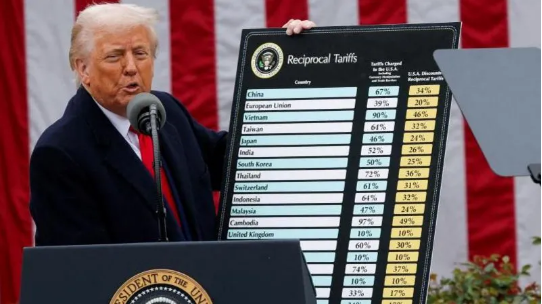

In what he described as a “correction decades in the making,” Trump announced sweeping new tariffs on imports from a host of nations. The policy - deemed the American Economic Restoration Plan - targets countries with significant trade imbalances with the United States.
Among the hardest hit are China, Vietnam, Germany, Mexico, and even long-standing allies like Japan and South Korea.
In retaliation, the European Union, Canada, and India have unveiled their own countermeasures, imposing tariffs on American agricultural exports, machinery, and even cultural products. The global trade environment has quickly descended into a tit-for-tat standoff reminiscent of the 2018-2019 trade wars, but on a grander scale.
Still, amidst the frenzy, a curious pattern emerged in the tariff figures displayed by the Trump administration. A closer look reveals a simple but powerful formula at play: Tariff Rate = Trade Deficit / Cost of Goods Exported
Let’s take a concrete example from the Trump administration’s newly released tariff chart:
European Union (E.U.):
- U.S. Imports from E.U.: $531.6 billion
- U.S. Exports to E.U.: $333.4 billion
- Trade Deficit: $198.2 billion
- Tariff: $198.2B / $531.6B = 37%, closely matching the 39% tariff rate shown in the chart.
Trump Administration Tariff Rate Chart:
Country | Exports to U.S. (B) | U.S. Exports (B) | Trade Deficit (B) | Calculated Tariff | Displayed Tariff |
China | 572.4 | 121.8 | 450.6 | 79% | 80% |
Vietnam | 129.6 | 11.3 | 118.3 | 91% | 90% |
E.U. | 531.6 | 333.4 | 198.2 | 37% | 39% |
Mexico | 475.3 | 282.2 | 193.1 | 40.6% | 41% |
Japan | 161.2 | 71.5 | 89.7 | 55.6% | 55% |
This pattern isn’t a coincidence. It reveals a two-fold strategy behind Trump’s renationalization campaign:
One is closing the trade deficit at all cost. By penalizing imports from nations with which the U.S. has substantial goods deficits, the administration hopes to rebalance trade - even if it means passing costs onto the American consumer.
Higher import tariffs will inevitably raise prices for goods ranging from electronics and apparel to automobiles and furniture. But for the Trump administration, this is a necessary price to pay for economic sovereignty.
Two is reclaiming manufacturing and 'real jobs': The targeted tariffs signal an aggressive effort to revive American manufacturing. The administration’s rhetoric places a premium on "real jobs" - factory work, construction, production, and skilled trades, over what it deems "service economy excesses," such as marketing, analysis, and management roles that have proliferated over the last four decades.
Indeed, countries with higher tariffs on the Trump chart - like China and Vietnam - share a key trait: large goods-based trade surpluses with the U.S. This underlines the administration's focus on tangible production, the kind that once powered American industrial might in the early to mid-20th century.
This policy shift is also informed by a deeper economic philosophy. Dr. Stephen Miran’s article, A User’s Guide to Restructuring the Global Trading System, often referenced in policy circles as the foundation of the informal “Mar-a-Lago Accords,” argues for managed, bilateral trade. Miran contends that globalism has undermined national strength by promoting efficiency at the expense of strategic self-sufficiency.
The Trump administration’s tariffs reflect this thinking. They prioritize economic sovereignty over market liberalism, aiming to recalibrate U.S. trade policy to serve national power, not just profit.
GEOPOLITICAL STAKES AND NATIONAL SECURITY
This isn’t just an economic dispute - it’s a strategic one. A 2024 Pentagon report titled Defense Industrial Fragility and Foreign Dependency outlines over 600 supply chain vulnerabilities where the U.S. relies on adversarial nations like China for critical military components. These include microelectronics, rare earth minerals, semiconductors and ammunition components
The report warns that even short-term supply chain disruptions could cripple American defense readiness. The COVID-19 pandemic previously exposed similar vulnerabilities in pharmaceuticals and medical supplies, many of which are sourced from China.
In this light, the tariffs function as a national security measure. By incentivizing domestic production, the administration aims to rebuild critical industries and reduce strategic dependency on foreign suppliers.
The Trump administration’s tariffs mark a definitive shift from decades of globalist trade policy toward a new paradigm of economic nationalism. Far from being arbitrary, the tariffs follow a clear economic rationale and a broader strategic doctrine. They reflect a belief that America’s strength must rest on industrial self-sufficiency and economic independence.
Though controversial, this renationalization agenda is already reshaping global trade. As the world adjusts to this new reality, the central question remains: can the U.S. rebuild its industrial core without igniting a new era of global economic instability?
Whatever the outcome, one thing is clear - American trade policy has been fundamentally redefined.
Peterson C. Waweru is a Young African Diplomat Fellow, International Relations Society of Kenya (IRSK), Research Fellow at Tokyo Foundation for Policy Research (Japan) and a researcher at the UoN Department of Diplomacy and International Studies












